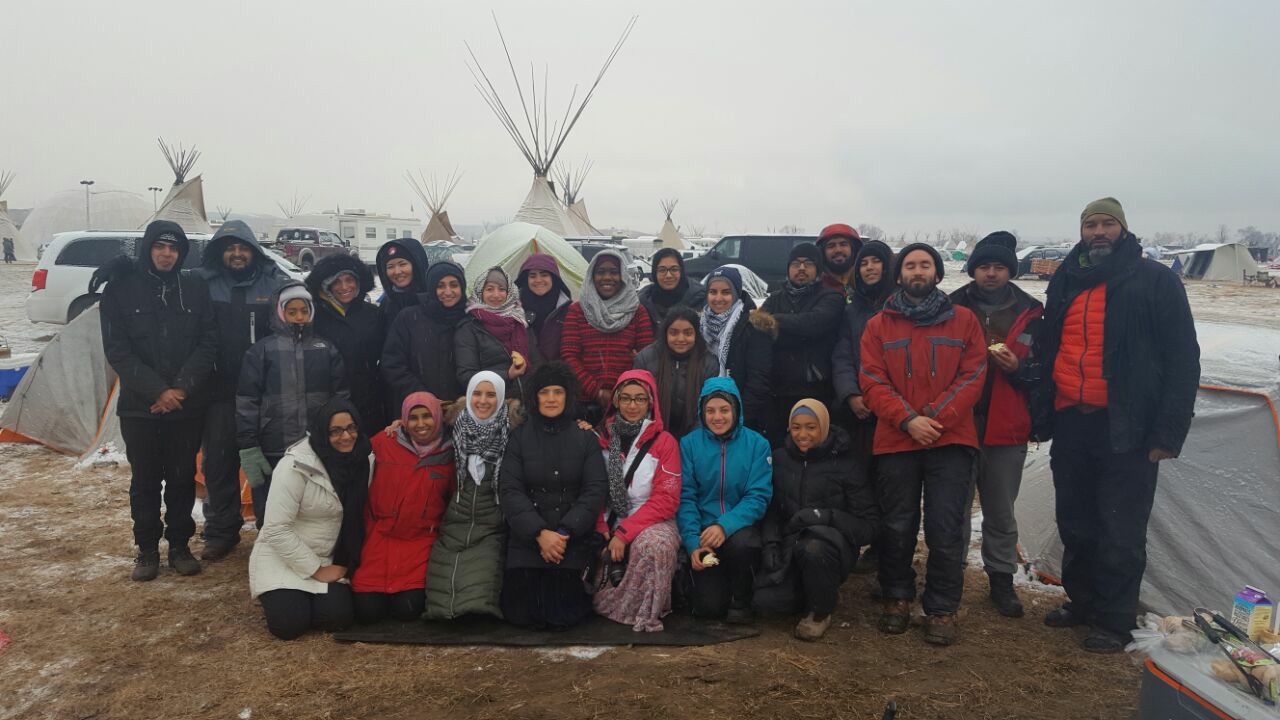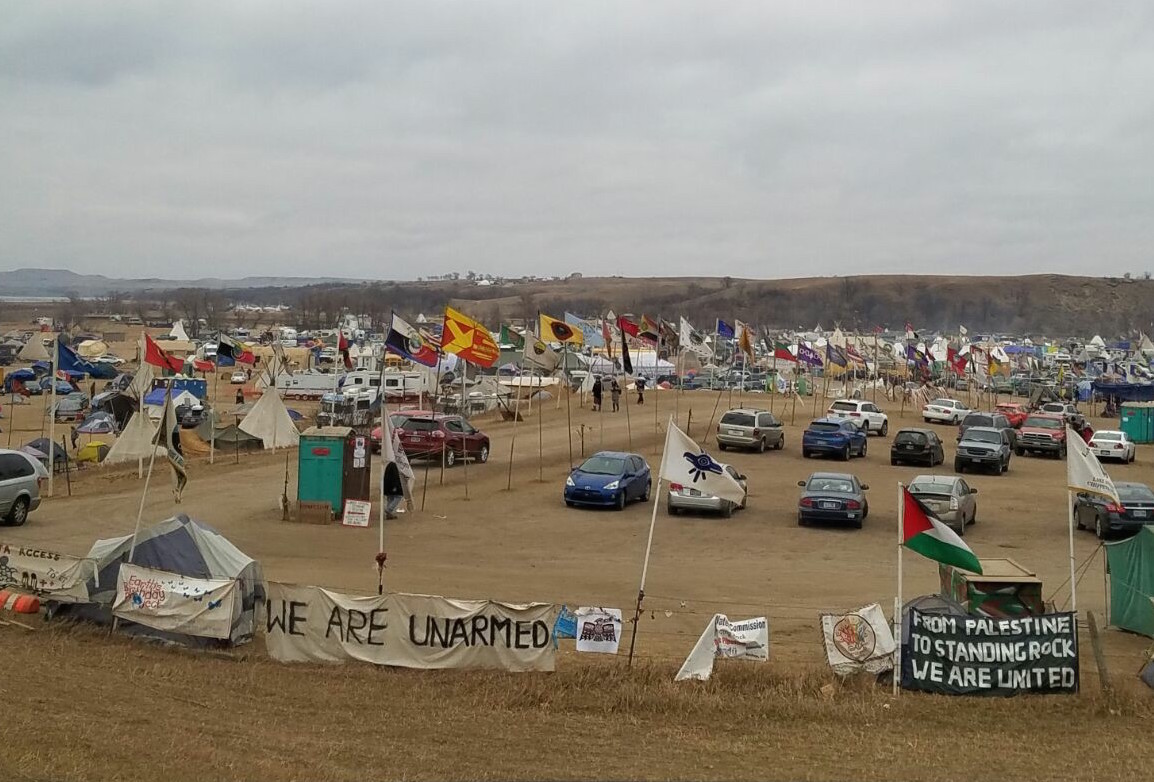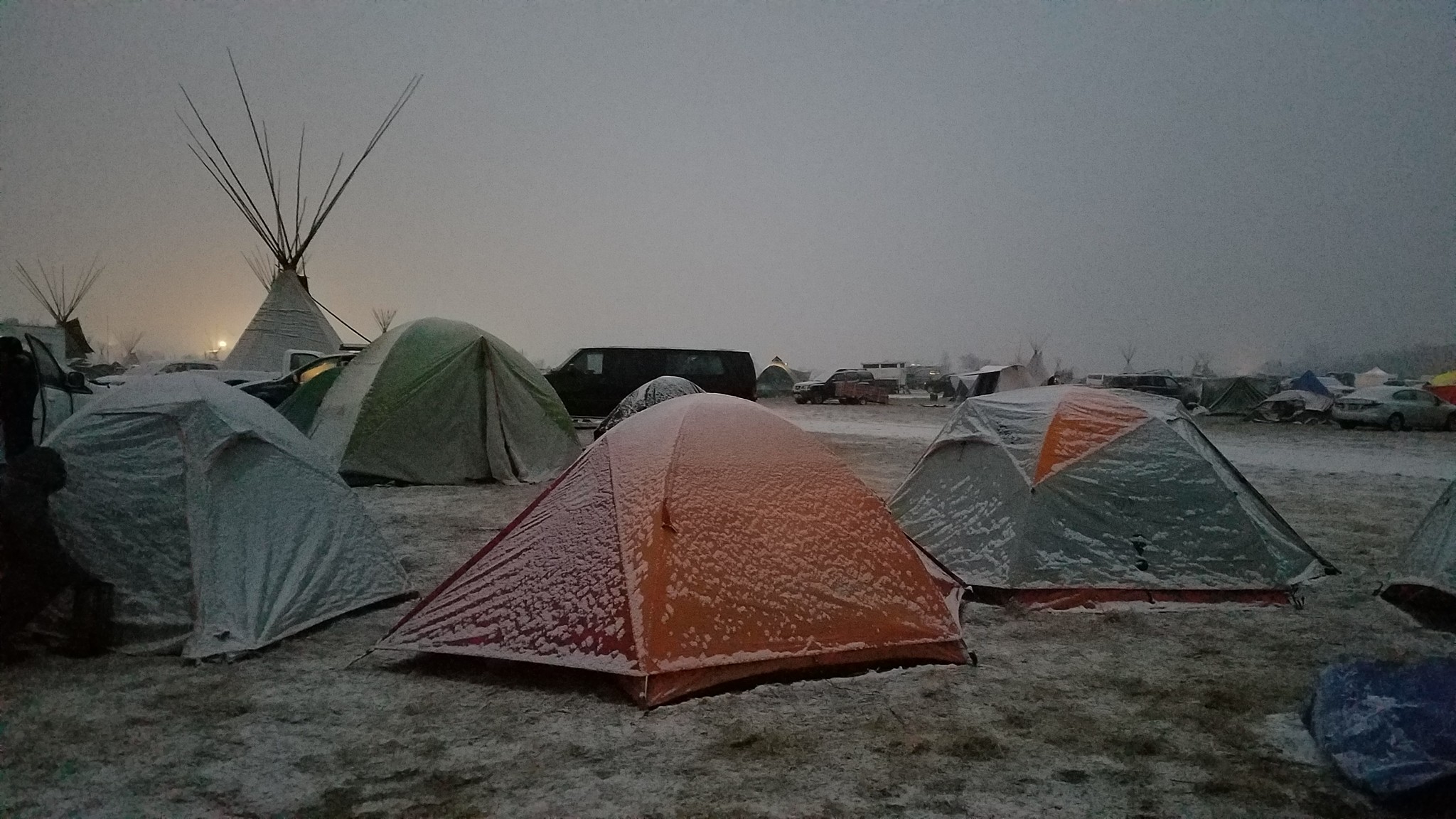Members of the Islamic Center at NYU and students from Zaytuna College in Berkeley, CA, who attended the service trip to Standing Rock.
Late this fall, like others around the world, I began slowly gaining greater consciousness and awareness of the situation at Standing Rock. This growing awareness accelerated as millions “checked in” to Standing Rock on Facebook in a show of solidarity. As I saw friends and acquaintances ranging from elementary and high school through college and law school take part in this wave of check-ins, I felt pride and relief that such a wide cross-section of people I know – even those from a small Midwestern town who had never left – empathized with the oppression of people they had never and would likely never meet. Yet, even as I checked in myself, I anticipated the criticism that would come from those accusing the people checking in of slacktivism. I knew the criticism might, on some level and in some instances, be justified, despite the good intentions of all those who checked in. I found myself, for a moment, fantasizing about the possibility of simply renting a car and driving to North Dakota, and checking in to Standing Rock for real.
I was fortunate that just as I began pondering this scenario, the Islamic Center at New York University (ICNYU) sent out an email asking for applications for a service trip to Oceti Sakowin. For those who are considering going to Standing Rock, many weigh the opportunity: Is it better to go for a few days and show solidarity, or more pragmatic to instead donate directly to the camp the hundreds of dollars one might spend on travel? For those of us who traveled with ICNYU, however, the answer to this question was simple: The Lakota had put out a call for people to come and join them in sacred ceremony, and we wanted to answer this call to prayer.
After plane delays and reroutes, we arrived not in Bismarck as planned, but in Fargo, and began the trek to Bismarck. During the four-hour drive, we gained a brief glimpse into North Dakota: small towns and large prairies, where our group of 13 Muslims stood out sorely. We had extremely poor cell phone reception outside of Bismarck and navigated the final stretch to Standing Rock the old-fashioned way: through printed directions and maps. As our two rented vans wove through the long, empty country roads, passing an alarmingly high number of cattle and alarmingly low number of people, we ran into the first major glitch after the plane delays: members of the U.S. armed forces (I presume the National Guard), who had erected a gate and were stopping cars, including ours, as they attempted to drive onto the bridge that led to the camp.
A view of Flag Road at Oceti Sakowin camp, including the Palestinian flag and "We Are Unarmed" sign.
Immediately, I had flashbacks of an old trauma: driving through Palestine and being stopped at every checkpoint by Israeli soldiers. As we pulled up to the gate, stopped and rolled down our windows, I felt the same sense of vulnerability, dread, and being trapped that I had felt so often in the West Bank. Just like in Palestine, we had our official line planned: we were on a service trip for the Lakota tribe. Thinking back to anticipated searches through phones and computers at the Tel Aviv airport, I put my cell phone out of sight and instructed my passenger seat occupant to do the same.
The soldier in this case was polite enough, saying that protestors had burned a car on the bridge a few weeks ago and although law enforcement had removed the car this past weekend, the bridge had not yet been checked out as remaining structurally sound after the fire. He gave us alternative directions and we went on our way, eventually arriving at the Oceti Sakowin camp just before 10 p.m. – arriving a day late and under the blanket of darkness, filled with excitement for what the next day’s light would reveal. As we prepared to get quickly into our tents and rest before our first day, we heard drones flying overhead in the cloudy night sky and saw humungous, intensely bright floodlights the U.S. Army had set up at the front line of the camp. Both the drones and the floodlights, we were told, were to disturb the sleep of the Water Protectors. Perhaps it was a clear conscience as to what side of that front line we were on, but drones and floodlights notwithstanding, we slept very well indeed that first night.
After this well-deserved rest, our first task in the morning – following our own daily Islamic pre-dawn prayer – was to attend the 7:30 a.m. large prayer around the camp’s sacred fire. All seven of the Sioux nations, who have united for the first time in almost 200 years, lit the Seven Councils Fire in unity against the pipeline.
As a human rights advocate, before inserting myself into a situation, I attempt to do my best to be aware and intentional of my role as an outsider and how I can best contribute without overstepping. However, at Standing Rock, this extra effort proved completely and welcomingly unnecessary: At the daily newcomers orientation that we attended after the large group prayer, the orientation leaders gave clear, precise, and helpful guidance as to the nature of the camp, our expected roles as brief outsiders visiting, and how to best observe the customs of the camp. Their information was concrete and eye-opening, and set a tone that emphasized the indigenous leadership of the camp that we were expected to respect and follow. We learned about the seven Lakota values, and we were encouraged to live up to them while at the camp.
- Prayer. This is first and foremost a prayer camp; remember you are a guest; be optimistic; women who are on their menstrual cycle must avoid going into the kitchens or near the sacred fires, as menstruation is considered an internal ritual, and just as you would not mix medicines, you should not mix rituals.
- Respect. When an elder enters, offer your seat; women should wear skirts over their winter clothes; do not eat in a group if you do not have enough to offer to everyone else; never arrive to a gathering late or leave early – the gatherings open and close with a prayer, and you should catch both prayers.
- Compassion.
- Honesty. Don’t make a suggestion for the camp – even if something seems inefficient to you – unless you personally are going to be the one to stay long-term and see the implementation of that idea through.
- Generosity. As much as you can, give more than you take in terms of people’s energy, clothing donations, food, and medical services offered, especially if you are here for a short time.
- Humility. The camp is a drug and alcohol-free zone; don’t jump to share your ideas – listen first; check in with your neighbors if they are doing all right.
- Wisdom. Respect the elders; make them an offering when approaching them for wisdom; remember that the camp is in a constant state of prayer and ceremony.
The orientation also emphasized that we were guests, and were expected to follow the indigenous leadership at all times, including in maintaining the centrality of prayer and ceremony. The camp was put into the context of the 500-year history of settler colonialism in this country. The orientation was powerful and moving in how it clearly conveyed the strong sense of identity among the Lakota people, their continuing values and traditions, and was unapologetic in asking guests to respect and observe them (even those that would seem archaic in broader contexts, such as asking women to wear skirts or stay away from sacred spaces while on their menstrual cycle). When movements undertake their PR strategies, the focus is often taken on how to best package the message; at Standing Rock, there is so much more authenticity than in this usual procedure. The Lakota sense of identity is so strong and unadulterated that others are not alienated, but in fact drawn in.
The approach the Lakota have taken to reaching out to the world made me reconsider what we often see as default PR mechanisms: For example, to not contribute to cultural appropriation, there is absolutely no photography allowed at sacred ceremonies such as at the sacred fire – which is perhaps the absolutely central aspect of the camp – or of indigenous people without their explicit permission (and we were reminded that unless we were in relationship with that person, to not overstep and ask for permission to take their picture anyway). Those following the news will see pictures of the front lines and the direct actions, but that does not represent the essence of the camp, which is prayer and ceremony found in photography-free zones such as the sacred fire. And yet, despite no pictures of this ceremony, thousands have been drawn to answer the call of the Lakota anyway. The success of this call is a reminder to reflect on the importance of authenticity in designing marketing strategies for our well-meaning human rights efforts.
Daylight breaks over the ICNYU and Zaytuna tents at the Oceti Sakowin camp on Thanksgiving morning.
Following orientation, we broke out into groups to find our volunteer tasks for the day. We kept in mind the advice provided at orientation: find one volunteer task and stick with it rather than jumping around to various tasks, requiring others to take more time and energy to train you again and again in each new task. Many of us ended up at the donations tent, where we sorted through the piles and piles of donations people had sent in, ranging from the heartwarming (hand-knitted mittens with handwritten notes of encouragement attached) to the absurd (used undergarments), sorting things into piles and labeling them to be hung up in the “shopping” tent for Water Protectors who needed extra warmth in the North Dakota winter. As prepared as our team had come with camping supplies and food and thermal layers, many of us still borrowed extra gloves or boots from the donations tent – returning the items before leaving the camp – to help stay warm. It was a reminder of the absolute necessity for supporters to come to Standing Rock prepared to ensure you can withstand the elements and therefore remain in a position to contribute to the camp. I had gone in with the expectation of volunteering for most of the daylight hours, but with the freezing temperatures, I worked for perhaps less than half that expected time.
The camp had absolutely no cell phone reception other than at a hill lovingly referred to as “Facebook Hill,” and so, much like we learned to navigate our drive to the camp without GPS, we learned to navigate our way around the camp and through our daily communications with each other without the benefit of cell phones. This was bolstered by the internal connections in the camp: People from the nearby reservation and community center had opened their doors for Water Protectors in staying in the camp who might need an indoor bathroom/shower; as instructed in the orientation, we were all encouraged to make eye contact and share a greeting when passing by anyone walking in the camp (we laughed about the unfeasibility of bringing this custom back to the mean streets of New York City). Despite this, the absence of our usual ever-present cell phones might have resulted in a feeling of disconnect with the state and country and world outside of Oceti Sakowin, but instead there were reminders all around us of the camp’s ties to the world at large.
The main road in the camp, referred to as Flag Road, was lined with tall flags from various indigenous tribes and from countries around the world where official and unofficial delegations had visited the camp and offered their flag out of solidarity. It was a constant validating reminder that the injustice occurring at Standing Rock was not so invisible to people around the world, putting this struggle into a larger network of solidarity and support. One of the most moving was the Palestinian flag, flown proudly next to a sign that proclaimed, “From Palestine to Standing Rock, We Are United.” These small moments served as reminders that despite the physical remoteness of Standing Rock, the movement is fostering deep connections around the world.
Having spent the entire day in the elements, wearing four sweaters, four pairs of pants, three pairs of socks, two pairs of gloves, and three scarves; desperately borrowing heat packets to use in my gloves from a friend who had thought to bring some; and still failing to keep warm, and knowing we were going to awake the next day to an expected frost, for me it was an enormous psychological struggle to get back into the tent that second night and not simply drive off to a nearby hotel instead. After only 24 hours in the camp, I was emotionally fatigued from being in the elements and having nowhere to go inside; I cannot begin to fathom the mental resolve required to stay for days or weeks or months on end.
A direct action by the Water Protectors, barely visible behind heavy police presence, as they block an intersection in Bismarck on Thanksgiving Day.
We left the camp on Thanksgiving morning. Driving to the airport, we ran into one of the planned direct actions for this meaningful day: blocking a road in Bismarck. We could barely see the protestors behind the barricade of police, who appeared at first impression to both outnumber the protestors – who were only holding up signs – and be outfitted for war. Stopping for breakfast at a Cracker Barrel in Bismarck, our large, Muslim group walked in to a whisper, “They must be protestors,” and we listened as a waiter politely complained about the disruption to daily life the Water Protectors were causing. As Louis Butcher, a Lakota convert to Islam known to us as Brother Basheer, said, despite the hostility of local residents to Oceti Sakowin, their water will be affected by the pipeline as well, and if and when that reality materializes, they will wish they had been standing with the Water Protectors.
Upon my return to New York City and to a reliable cell phone signal, I received a message from a friend saying she had heard I had visited Standing Rock, she was angry about the situation, and asked what she could do to contribute. I told her there were three immediate things, and I’ll leave them here with you:
1) Stop saying “Native Americans.” Many of us are taught in elementary school that this is the respectful term, but as we were asked during orientation, how can people who were on this land before the concept of “America” existed be native to that concept? Say “native peoples” or “indigenous peoples” instead.
2) Learn where you are from and start introducing yourself in that manner. For example, my name is Asma, I grew up in occupied Pottawatomi territory, also known as Monroe, Michigan. I currently live and attend law school in occupied Lenape territory, also known as Manhattan. This “de-centers settler worldviews/practices and re-centers indigenous worldviews/practices and leadership,” as encouraged in the orientation.
3) Donate. The weather is unbelievably brutal. As I left – admittedly in a hurry to finally get somewhere that was inside – I thought about how I had the freedom to leave, without historical and personal connections to the land and water keeping me there. Despite the announcement that the easement for the pipeline – the black snake, as the Lakota call it – has been denied, the Water Protectors remain at Standing Rock for the long term, saying the goal is to prevent the pipeline altogether. We’re in the depths of winter, with only more cold weather to come. Donate here: ocetisakowincamp.org/donate.
Asma Peracha is a currently a third-year law student at New York University School of Law and looks forward to graduating next year. She has been an intern at the Center for Constitutional Rights since October 2016.





